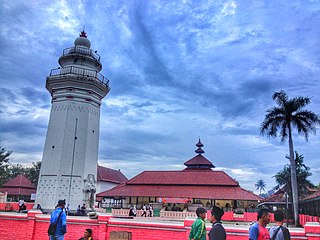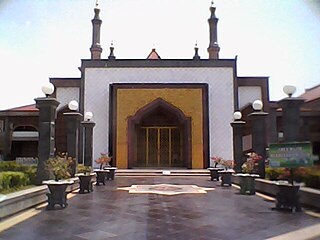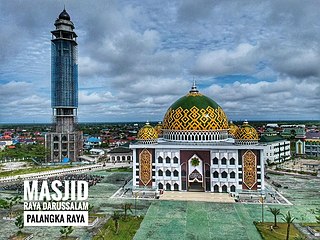
Demak Great Mosque is one of the oldest mosques in Indonesia, located in the center town of Demak, Central Java, Indonesia. The mosque is believed to have been built by the Wali Songo with the most prominent figure Sunan Kalijaga, during the first Demak Sultanate ruler, Raden Patah during the 15th century.

Serang is a city and the capital of Banten province and was formerly also the administrative center of Serang Regency in Indonesia. The city is located towards the north of Banten province, on the island of Java; the north part of the city contains the coast zone facing onto Banten Bay, and includes the historical site of Old Banten, after which the province is named. Before Banten province was formed in 2000, Serang city was part of West Java province.

The Menara Kudus Mosque or Al-Aqsha Mosque is located in Kudus in the Indonesian province of Central Java. Dating from 1549, it is one of the oldest mosques in Indonesia, built at the time of Islam's spread through Java. The mosque preserves the tomb of Sunan Kudus, one of the nine Islamic saints of Java, and is a popular pilgrimage point.

Jama Masjid, also known as Jumah Mosque or Jami' Masjid, is a mosque in Ahmedabad, Gujarat, India. It was built in 1424 during the reign of Ahmad Shah I. The inscription on the central mihrab commemorates the inauguration of the mosque on the 1st Safar A.H. 827 or January 4, 1424 A.D. by Sultan Ahmad Shah I. The mosque lies in the old walled city, and it is situated outside Bhadra Fort area. The old walled city is divided into separate quarters or pols, and the Jami' Masjid is found on the Gandhi Road. Along the south side of the road, the mosque is a short distance beyond the Teen Darwaza or Tripolia Gate.

Wapauwe Old Mosque is a historic mosque in Kaitetu village, located in the Wawane Mountains on the north part of cape Keitetu, Maluku, Indonesia. Established in 1414, it is the oldest mosque in the Moluccas and possibly the oldest mosque in Indonesia which has been maintained in its original state.

The Great Mosque of Surakarta is an 18th-century Javanese mosque in Surakarta, Central Java, Indonesia. It is the royal mosque of the Surakarta Sunanate.

The Great Mosque of Palembang, also known as Sultan Mahmud Badaruddin I Great Mosque after the former Sultan of Palembang, is the main mosque of Palembang, the capital of South Sumatra. The mosque is the largest in South Sumatra, and the third largest mosque in Sumatra after the Grand Mosque of West Sumatra and Great Mosque of Pekanbaru.

Kasunyatan Mosque is a small mosque in the village of Kasunyatan, Banten, Indonesia. Established between 1570 and 1596, it is one of the oldest mosques in Indonesia. The mosque is located in close proximity to the ruins of Old Banten, and functioned as a 16th-century centre of Islamic study. The mosque received a heritage status during the Dutch colonial period in 1932.

The Grand Mosque of Bandung, previously known as the Great Mosque of Bandung, is a mosque in Bandung, the provincial capital of West Java, Indonesia. The mosque received the status of provincial mosque of West Java Province in 2004. It is located on the east side of the alun-alun of Bandung.

Great Mosque of Banten is a historic mosque in Old Banten, 10 km north of Serang, Indonesia. The 16th-century mosque was one of the few surviving remnants of what used to be the port city of Banten, the most prosperous trading center in the Indonesian archipelago after the fall of Demak Sultanate in mid-16th century.

The Great Mosque of Malang is a mosque located in Malang, Indonesia. The mosque was built in 1890 and was completed in 1903, making it one of the oldest mosques in Indonesia. The mosque is square-shaped, constructed with steel, and has tajug on top. The original building is still maintained until today.
Dian Al-Mahri Mosque, also known as Golden Dome Mosque(Masjid Kubah Emas), is a mosque built on the edge of Raya street, Depok City in West Java, Indonesia. In addition to being a place of worship for everyday Muslims, this mosque complex is also a tourist area for family and attracts many people because of its domes made of gold. Because of the vastness of area and accessibility to the public, this place is often a holiday destination for family or a place to take a rest.

Mosque architecture in Indonesia refers to the architectural traditions of mosques built in the archipelago of Indonesia. Initial forms of the mosque, for example, were predominantly built in the vernacular Indonesian architectural style mixed with Hindu, Buddhist or Chinese architectural elements, and notably didn't equip orthodox form of Islamic architectural elements such as dome and minaret. Vernacular architectural style varies depending on the island and region.

Al-Wustho Mangkunegaran Mosque is a historic mosque located in the Central Javanese city of Surakarta, to the west of the Mangkunegaran Palace. The mosque is one of the three oldest mosques of Surakarta. Al-Wustho Mangkunegaran Mosque was inaugurated as a state mosque of the Mangkunegaran Palace.

Grand Mosque of Kubang Putih is an early 19th-century mosque located in the town of Kubang Putiah, West Sumatra, Indonesia. The mosque is designated as a cultural heritage object along with several other old mosques in West Sumatra, such as Bingkudu Mosque in Agam, Rao Rao Mosque in Tanah Datar, and the Ganting Grand Mosque in Padang.

At-Taqwa Mosque or At-Taqwa Grand Mosque is a historical mosque in the city of Cirebon, West Java, founded in 1918. Today it is one of the congregational mosques in Cirebon and considered an icon of the city. The mosque also provides Islamic learning as well as public services such as blood donation and a free ambulance.

The Great Mosque of Garut is a historical congregational mosque in the city of Garut, Garut Regency, Indonesia. The mosque is one of the oldest mosques in the region, first constructed on September 15, 1813 by the Dutch colonial representatives in the Priangan. The mosque was renovated three times in 1949, 1979, and 1998 into a traditional Javanese Islamic architectural style with sloped roofs.

Al-Hilal Mosque or Al Hilal Old Mosque of Katangka, better known as Katangka Mosque, is a historical mosque in South Sulawesi, Indonesia. Constructed in 1603 by the first Muslim ruler of the Sultanate of Gowa, Sultan Alauddin, the mosque is considered the oldest mosque in South Sulawesi.

Al-Bantani Grand Mosque is a congregational mosque in the city of Serang, Banten, Indonesia. With a capacity of 10,000 pilgrims, it is the second largest mosque in Banten province after the Al-Azhom Grand Mosque.

Darussalam Grand Mosque, Palangka Raya is one of the mosques in Central Kalimantan. This grand mosque is located on George Obos Street in the district of Jekan Raya, Palangka Raya. This mosque is situated within the Islamic Center area of Palangka Raya. This grand mosque is also one of the most important icons of the capital city of Central Kalimantan province.































